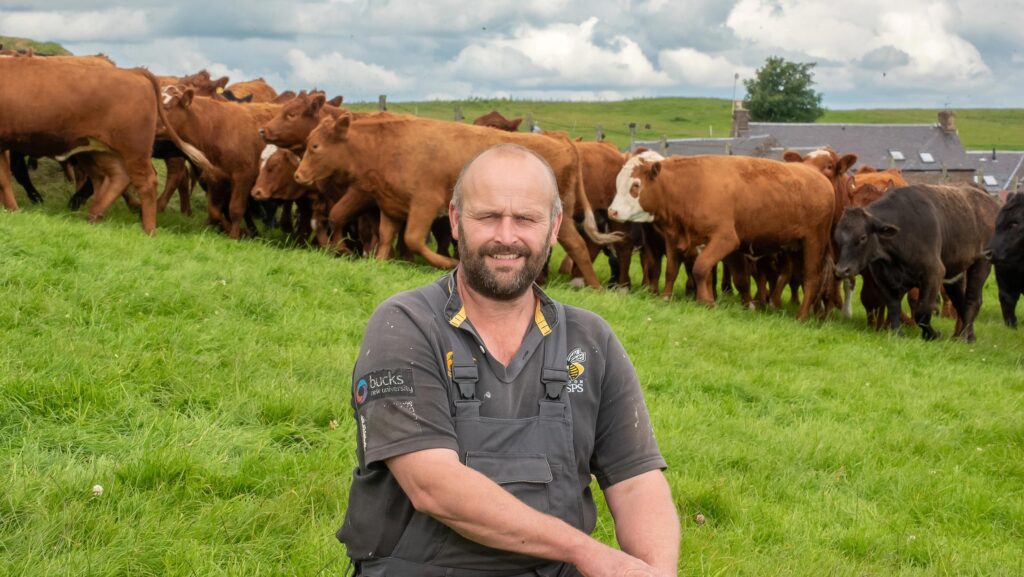Bumper grass growth but wet conditions hamper utilisation
 John Richie © Angus Findlay
John Richie © Angus Findlay Beef and sheep farmer John Ritchie, Farmers Weekly’s Grassland Manager of the Year 2023, replaced set stocking with rotational grazing on his Perthshire hill farm.
He is sharing updates about his 2024 grazing season.
In the second of the series, he tells what happened after a wet start to spring.
See also: How visiting other farms can improve business resilience
What have conditions been like since March?
Very wet until 10 April. Although it rained, it wasn’t bad weather and we had a good lambing.
We scanned at 197% and last week marked 173% – good for an outdoor lambing flock.
But it was still soggy underfoot and impossible to get cattle out.
They finally went out on 25 April, two weeks later than normal. Cows were still on the hill and yearlings went onto the grazing platform.
What has grass growth been like?
In April we were growing 35-40kg dry matter (DM)/ha. In May we had daylight hours and some heat, rather than cold and dry.
It has been wet and warm In the past two weeks, and on our unfertilised land last week it was 75kg DM/ha, and 120kg DM/ha on the silage ground.
This is ahead of average on previous years. It’s conditions underfoot that are a pain for stock and machinery.
How has the weather affected grazing?
It has been very wet for the past two weeks.
We have been co-grazing instead of leader-follower, so have had cattle and calves with ewes and lambs to give us more stock in the paddock, but for less time.
We have been on 1.5-day shifts (not two) and utilisation is poor.
To regain quality next time, we’re going to graze with sheep for two days, cattle for two days, then run with the mower to top it.
We have had a lot of leafy grass, so haven’t been worried about the sheep getting enough quality.
But seed heads are now starting to appear.
Have you made any silage yet?
We should have done our first cut on 30 May, but we had 35mm of rain the day before. We hope with a good forecast now to take it around 2 June.
All our silage is baled. First cut we use for growing cattle, with a block of red clover for twins and triplets.
It is dairy-cow quality at 11.5-12MJ of metabolisable energy (ME) and 15-16% protein.
We make dry cow silage in the third week of June that’s 50% headed and so about 10MJ of ME and 10-12% protein. It’s belly fill.
Farm facts: Montalt Farm, Perthshire
- Farming 272ha, of which 117ha grazing platform of improved swards
- 500 Logie Hybrid ewes lambing mid-April
- 105 Salers sucklers calving from March
- 90 paddocks of 1.3ha
- 7ha each year drilled with forage rape for outwintering and as entry to a reseed
- 120t/year of lime spread
- No fertiliser on grazing platform
- 37kg N/ha on silage fields
- 62kg N/ha on forage crops
- Grazing platform rested for 100-120 days over winter
- Average 8.2t DM/ha a year grown
- 1,000mm rainfall
- 300m above sea level
- Soils are shallow 15-18cm over rock
- Lambs sold direct
- Selling stores and breeding heifers
Your biggest challenge so far this season?
Grass utilisation. It has been very difficult for everyone this year. When it’s dry I reckon we hit 75%.
This really wet season we are struggling to get 65%.
But we can’t put pressure on ewes and lambs – they still need a choice.
They are like a high-performing dairy cow and if we get it wrong it affects lamb growth rates as they are taking 75% of the ewe’s diet in milk.
Wet ground has been tricky and we have some poaching. Once stock are out, though, it soon greens up and I don’t think we need to reseed.
Has anything gone well?
We have masses of silage, and as long as we can get it harvested, it’s an opportunity to replace stocks. We usually carry over 10-15% of our silage, but were cleaned out last winter. I don’t know what the quality will be like, though.
Also, we have had plenty of rain for establishing our fodder crops and the swedes are looking good. Cattle and sheep are looking well and, of cows put to the bull, 94% are running with a calf, so I am happy at the minute.
Looking ahead, what kind of summer do you want?
We have plenty of soil moisture, so can easily stand four or five weeks of dry weather now.
Have you any advice for other grassland managers?
I suppose this year, with grass growth not being a challenge, we need to watch for complacency.
There is a lot of opportunity to make winter feed, or put more stock on – it’s a double-edged sword.
Managing grass is hard and we need to get a balance.
And as it’s been a busy spring, once you’ve had your head down it’s very important at this time of year to get off farm and socialise and see other farms.
You need a break from lambing and calving.
